JEEP COMPASS 2015 1.G Owners Manual
Manufacturer: JEEP, Model Year: 2015, Model line: COMPASS, Model: JEEP COMPASS 2015 1.GPages: 560, PDF Size: 11.51 MB
Page 311 of 560

Control Setting Suggestions For Various Weather Conditions
4
UNDERSTANDING YOUR INSTRUMENT PANEL 309
Page 312 of 560

Page 313 of 560
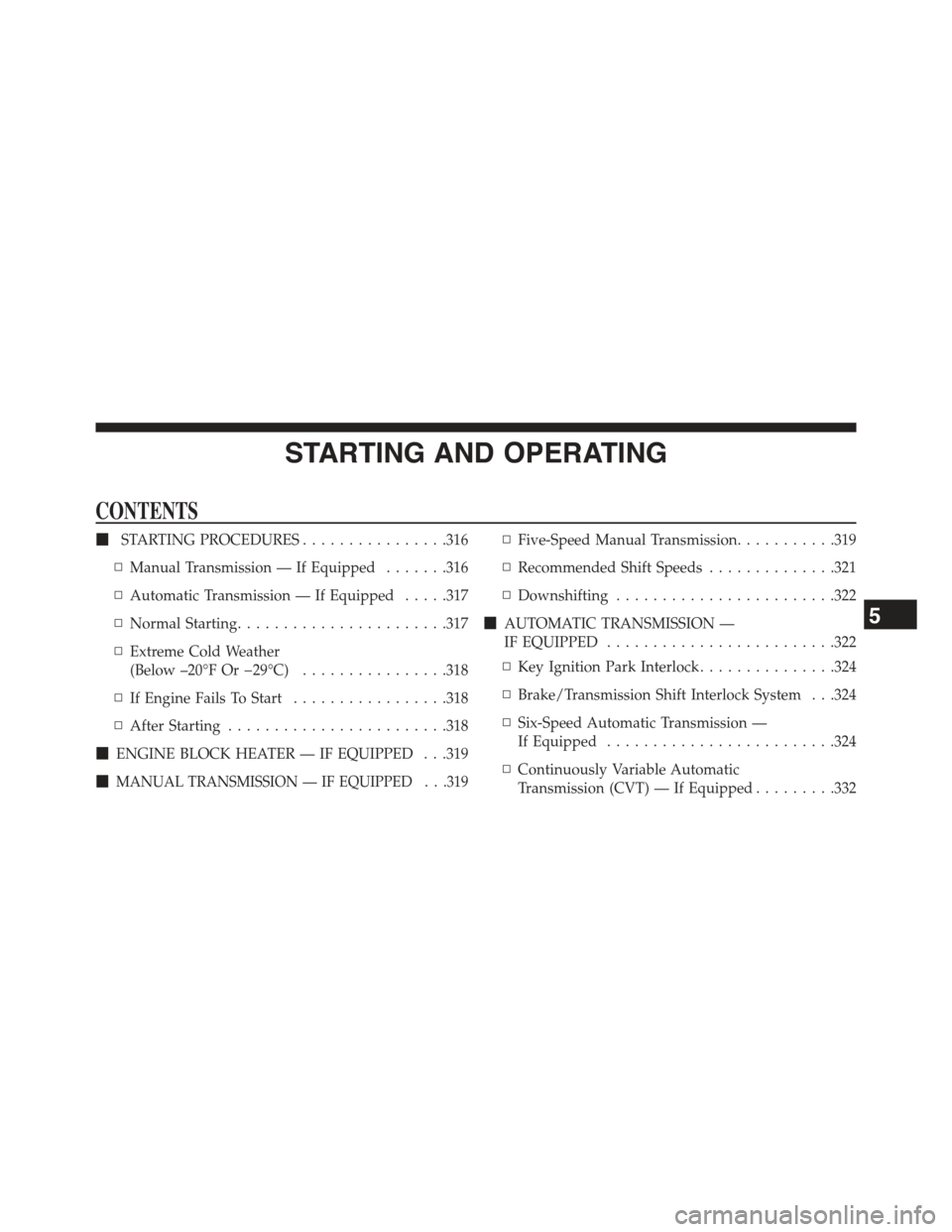
STARTING AND OPERATING
CONTENTS
!STARTING PROCEDURES................316
▫Manual Transmission — If Equipped.......316
▫Automatic Transmission — If Equipped.....317
▫Normal Starting.......................317
▫Extreme Cold Weather
(Below –20°F Or−29°C)................318
▫If Engine Fails To Start.................318
▫After Starting........................318
!ENGINE BLOCK HEATER — IF EQUIPPED . . .319
!MANUAL TRANSMISSION — IF EQUIPPED . . .319
▫Five-Speed Manual Transmission...........319
▫Recommended Shift Speeds..............321
▫Downshifting........................322
!AUTOMATIC TRANSMISSION —
IF EQUIPPED.........................322
▫Key Ignition Park Interlock...............324
▫Brake/Transmission Shift Interlock System . . .324
▫Six-Speed Automatic Transmission —
If Equipped.........................324
▫Continuously Variable Automatic
Transmission (CVT) — If Equipped.........332
5
Page 314 of 560
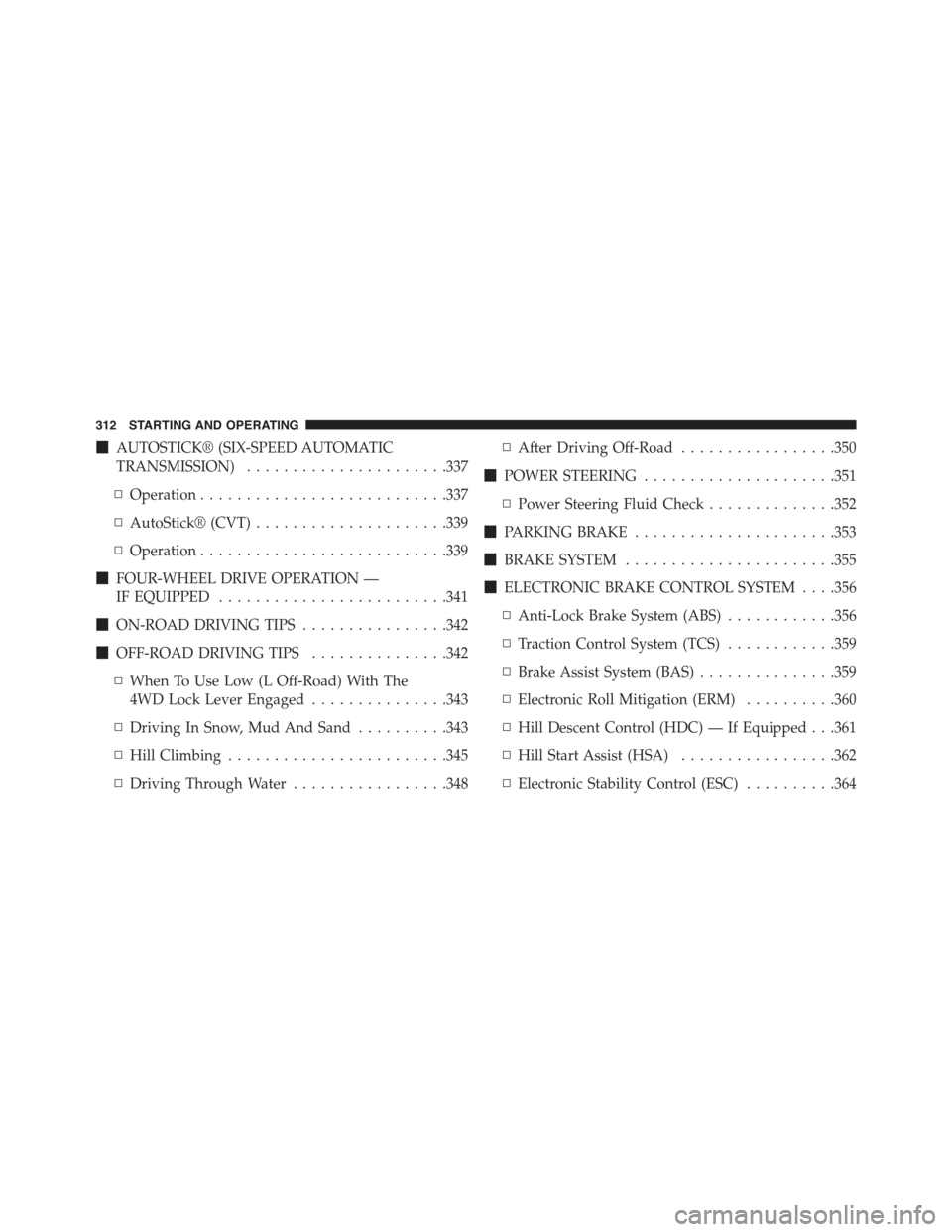
!AUTOSTICK® (SIX-SPEED AUTOMATIC
TRANSMISSION)......................337
▫Operation...........................337
▫AutoStick® (CVT).....................339
▫Operation...........................339
!FOUR-WHEEL DRIVE OPERATION —
IF EQUIPPED.........................341
!ON-ROAD DRIVING TIPS................342
!OFF-ROAD DRIVING TIPS...............342
▫When To Use Low (L Off-Road) With The
4WD Lock Lever Engaged...............343
▫Driving In Snow, Mud And Sand..........343
▫Hill Climbing........................345
▫Driving Through Water.................348
▫After Driving Off-Road.................350
!POWER STEERING.....................351
▫Power Steering Fluid Check..............352
!PARKING BRAKE......................353
!BRAKE SYSTEM.......................355
!ELECTRONIC BRAKE CONTROL SYSTEM . . . .356
▫Anti-Lock Brake System (ABS)............356
▫Traction Control System (TCS)............359
▫Brake Assist System (BAS)...............359
▫Electronic Roll Mitigation (ERM)..........360
▫Hill Descent Control (HDC) — If Equipped . . .361
▫Hill Start Assist (HSA).................362
▫Electronic Stability Control (ESC)..........364
312 STARTING AND OPERATING
Page 315 of 560
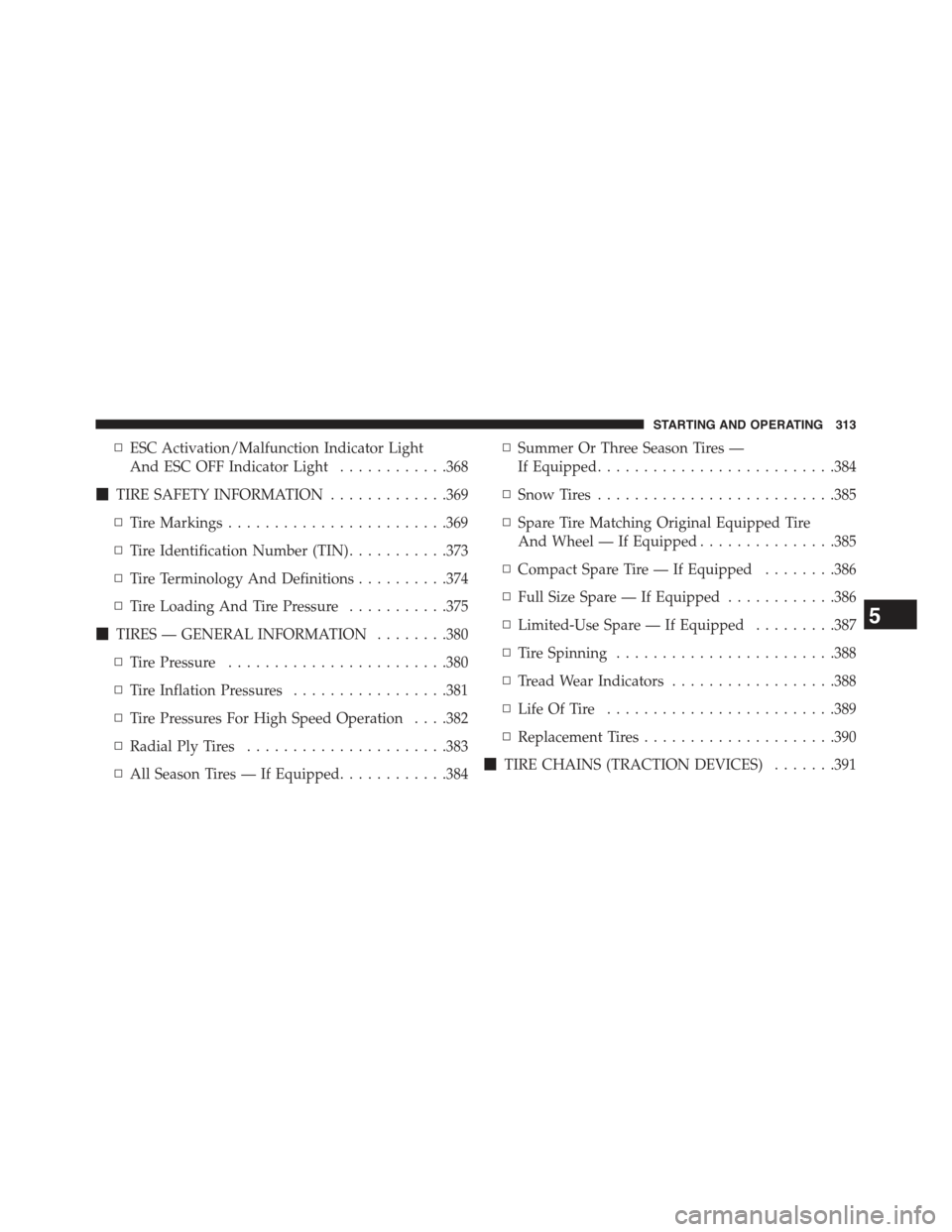
▫ESC Activation/Malfunction Indicator Light
And ESC OFF Indicator Light............368
!TIRE SAFETY INFORMATION.............369
▫Tire Markings........................369
▫Tire Identification Number (TIN)...........373
▫Tire Terminology And Definitions..........374
▫Tire Loading And Tire Pressure...........375
!TIRES — GENERAL INFORMATION........380
▫Tire Pressure........................380
▫Tire Inflation Pressures.................381
▫Tire Pressures For High Speed Operation . . . .382
▫Radial Ply Tires......................383
▫All Season Tires — If Equipped............384
▫Summer Or Three Season Tires —
If Equipped..........................384
▫Snow Tires..........................385
▫Spare Tire Matching Original Equipped Tire
And Wheel — If Equipped...............385
▫Compact Spare Tire — If Equipped........386
▫Full Size Spare — If Equipped............386
▫Limited-Use Spare — If Equipped.........387
▫Tire Spinning........................388
▫Tread Wear Indicators..................388
▫Life Of Tire.........................389
▫Replacement Tires.....................390
!TIRE CHAINS (TRACTION DEVICES).......391
5
STARTING AND OPERATING 313
Page 316 of 560
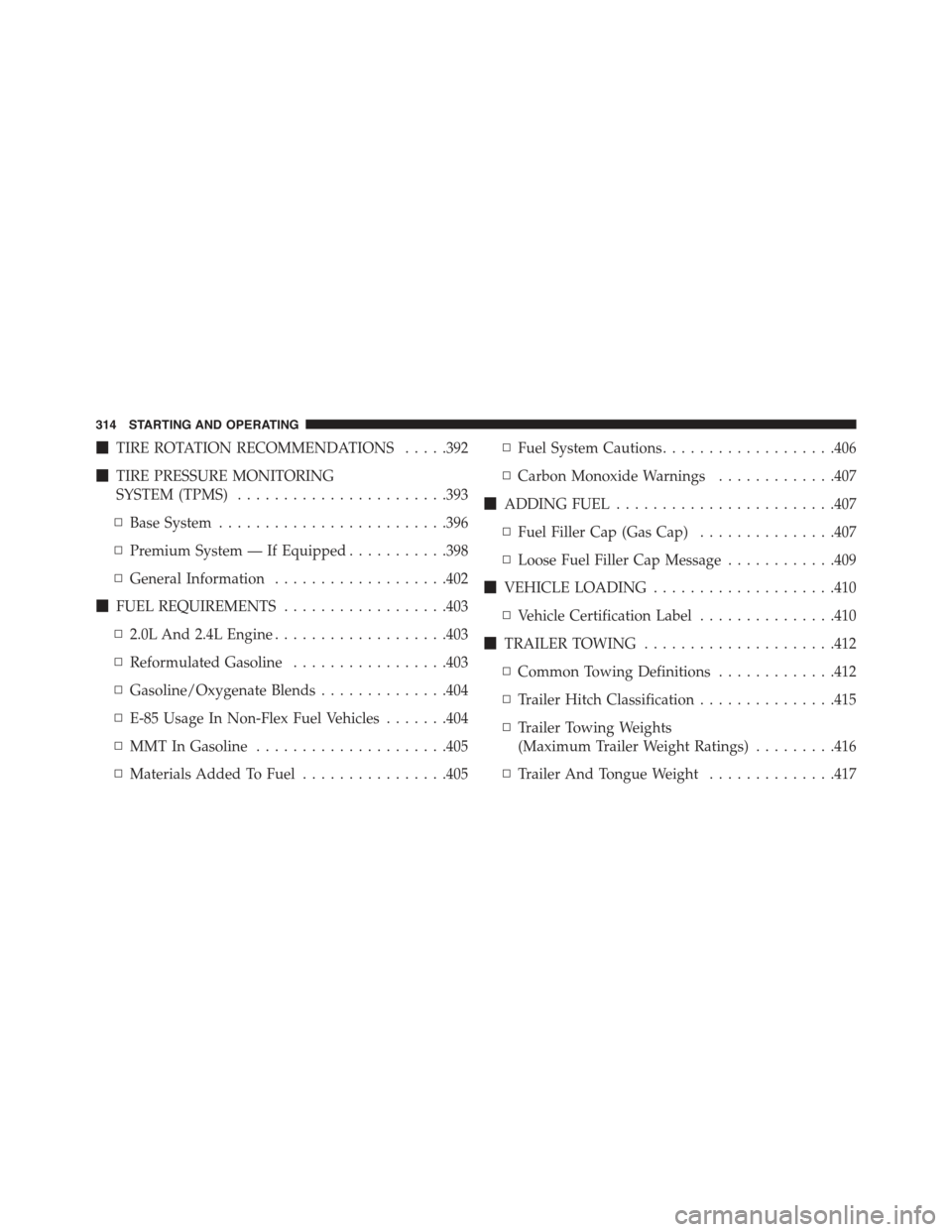
!TIRE ROTATION RECOMMENDATIONS.....392
!TIRE PRESSURE MONITORING
SYSTEM (TPMS).......................393
▫Base System.........................396
▫Premium System — If Equipped...........398
▫General Information...................402
!FUEL REQUIREMENTS..................403
▫2.0L And 2.4L Engine...................403
▫Reformulated Gasoline.................403
▫Gasoline/Oxygenate Blends..............404
▫E-85 Usage In Non-Flex Fuel Vehicles.......404
▫MMT In Gasoline.....................405
▫Materials Added To Fuel................405
▫Fuel System Cautions...................406
▫Carbon Monoxide Warnings.............407
!ADDING FUEL........................407
▫Fuel Filler Cap (Gas Cap)...............407
▫Loose Fuel Filler Cap Message............409
!VEHICLE LOADING....................410
▫Vehicle Certification Label...............410
!TRAILER TOWING.....................412
▫Common Towing Definitions.............412
▫Trailer Hitch Classification...............415
▫Trailer Towing Weights
(Maximum Trailer Weight Ratings).........416
▫Trailer And Tongue Weight..............417
314 STARTING AND OPERATING
Page 317 of 560
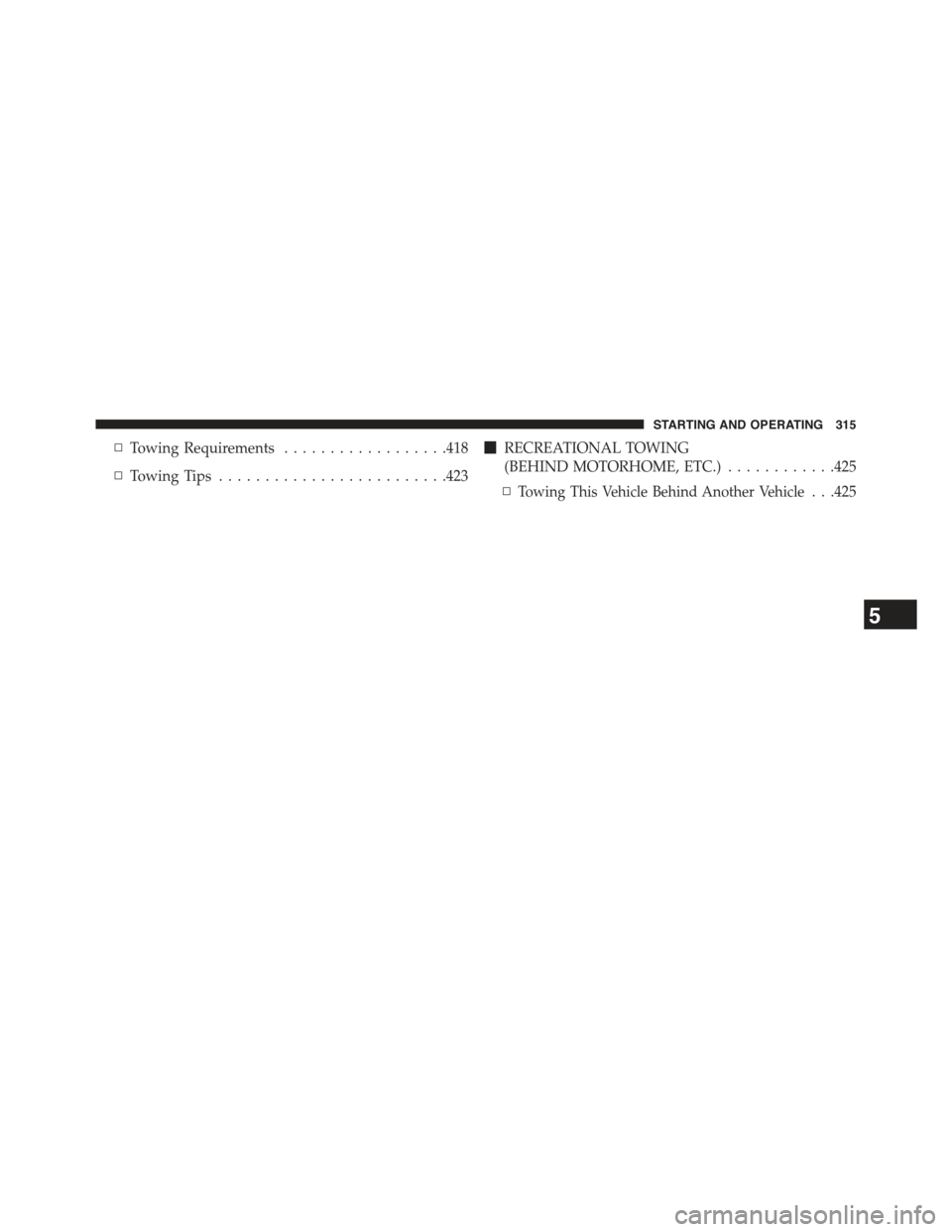
▫Towing Requirements..................418
▫Towing Tips.........................423
!RECREATIONAL TOWING
(BEHIND MOTORHOME, ETC.)............425
▫Towing This Vehicle Behind Another Vehicle. . .425
5
STARTING AND OPERATING 315
Page 318 of 560
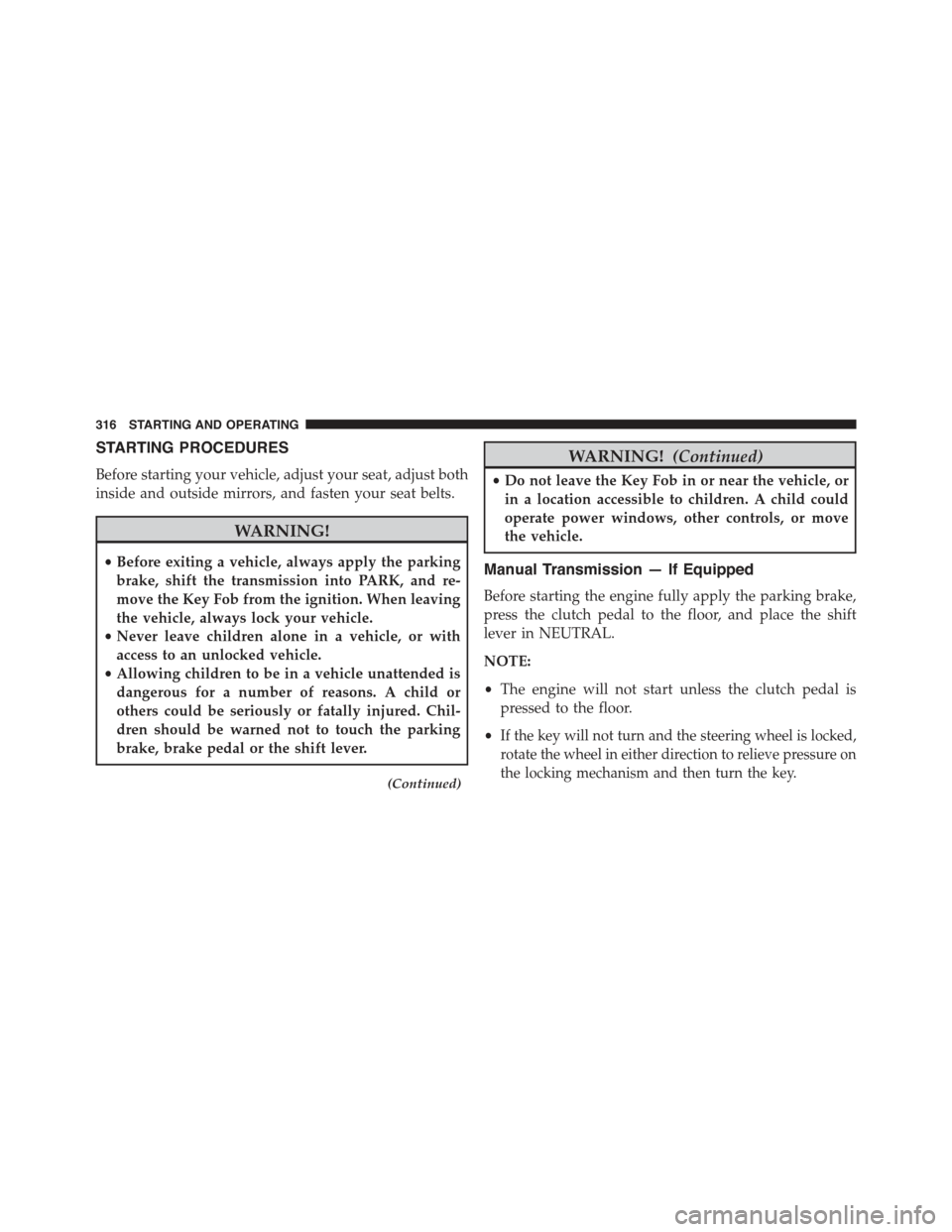
STARTING PROCEDURES
Before starting your vehicle, adjust your seat, adjust both
inside and outside mirrors, and fasten your seat belts.
WARNING!
•Before exiting a vehicle, always apply the parking
brake, shift the transmission into PARK, and re-
move the Key Fob from the ignition. When leaving
the vehicle, always lock your vehicle.
•Never leave children alone in a vehicle, or with
access to an unlocked vehicle.
•Allowing children to be in a vehicle unattended is
dangerous for a number of reasons. A child or
others could be seriously or fatally injured. Chil-
dren should be warned not to touch the parking
brake, brake pedal or the shift lever.
(Continued)
WARNING!(Continued)
•Do not leave the Key Fob in or near the vehicle, or
in a location accessible to children. A child could
operate power windows, other controls, or move
the vehicle.
Manual Transmission — If Equipped
Before starting the engine fully apply the parking brake,
press the clutch pedal to the floor, and place the shift
lever in NEUTRAL.
NOTE:
•The engine will not start unless the clutch pedal is
pressed to the floor.
•If the key will not turn and the steering wheel is locked,
rotate the wheel in either direction to relieve pressure on
the locking mechanism and then turn the key.
316 STARTING AND OPERATING
Page 319 of 560
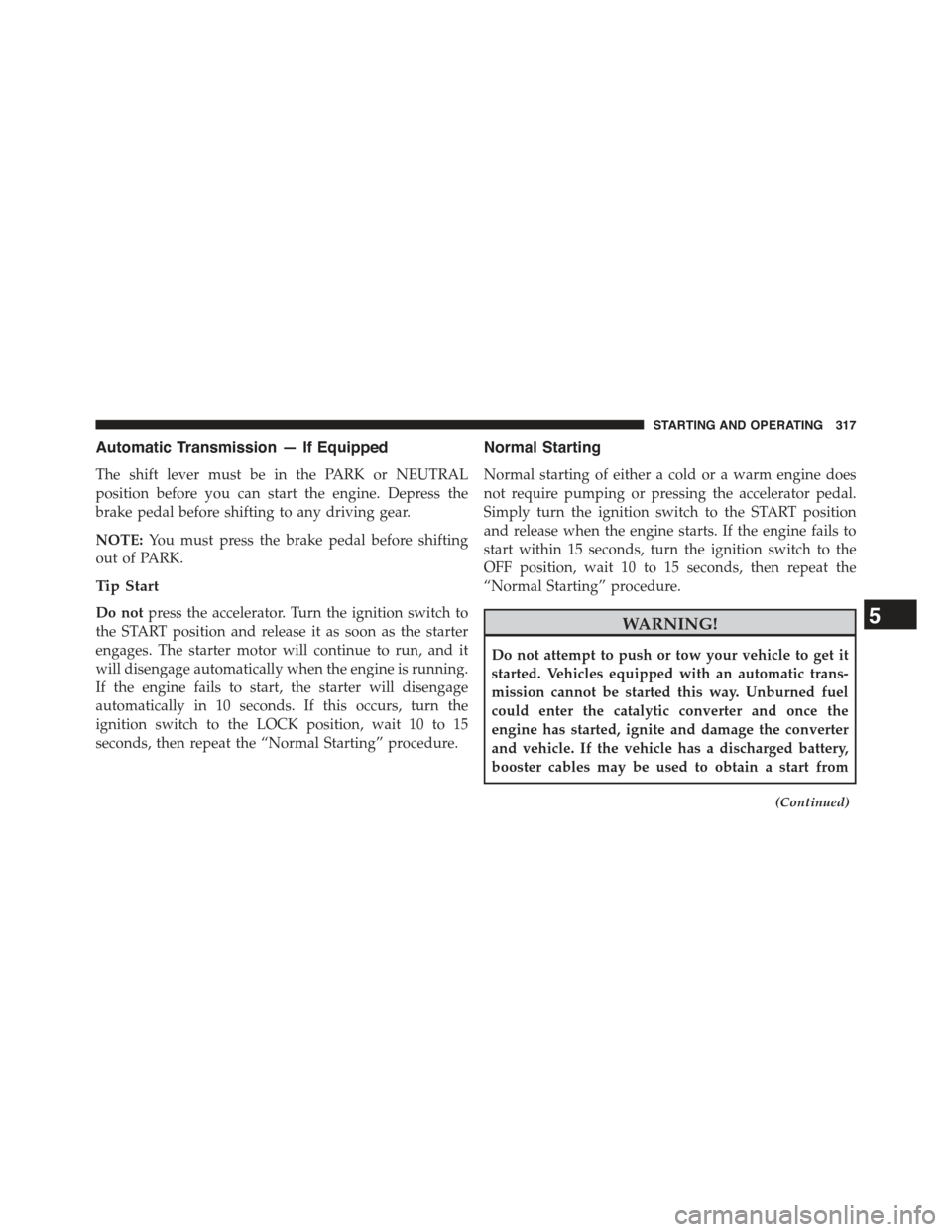
Automatic Transmission — If Equipped
The shift lever must be in the PARK or NEUTRAL
position before you can start the engine. Depress the
brake pedal before shifting to any driving gear.
NOTE:You must press the brake pedal before shifting
out of PARK.
Tip Start
Do notpress the accelerator. Turn the ignition switch to
the START position and release it as soon as the starter
engages. The starter motor will continue to run, and it
will disengage automatically when the engine is running.
If the engine fails to start, the starter will disengage
automatically in 10 seconds. If this occurs, turn the
ignition switch to the LOCK position, wait 10 to 15
seconds, then repeat the “Normal Starting” procedure.
Normal Starting
Normal starting of either a cold or a warm engine does
not require pumping or pressing the accelerator pedal.
Simply turn the ignition switch to the START position
and release when the engine starts. If the engine fails to
start within 15 seconds, turn the ignition switch to the
OFF position, wait 10 to 15 seconds, then repeat the
“Normal Starting” procedure.
WARNING!
Do not attempt to push or tow your vehicle to get it
started. Vehicles equipped with an automatic trans-
mission cannot be started this way. Unburned fuel
could enter the catalytic converter and once the
engine has started, ignite and damage the converter
and vehicle. If the vehicle has a discharged battery,
booster cables may be used to obtain a start from
(Continued)
5
STARTING AND OPERATING 317
Page 320 of 560
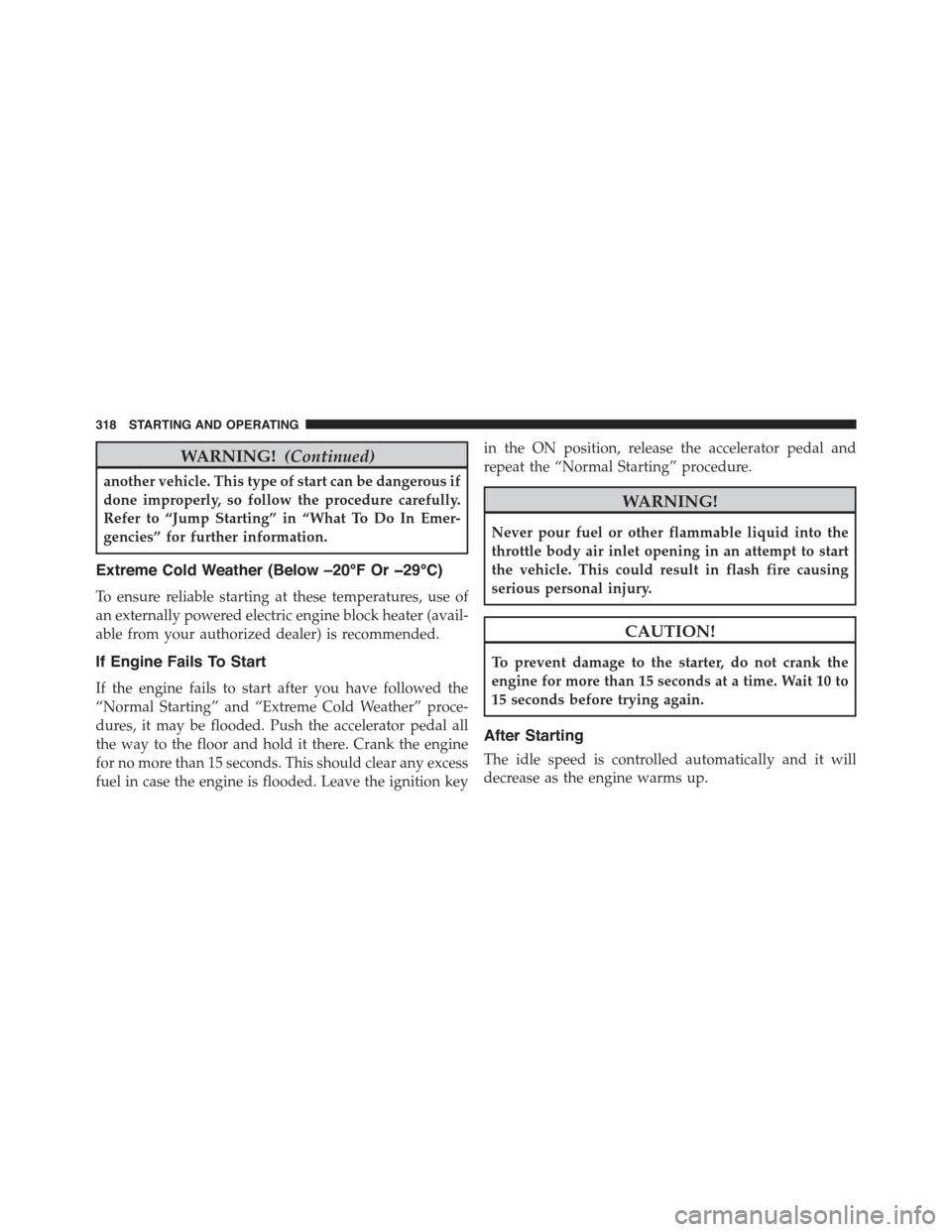
WARNING!(Continued)
another vehicle. This type of start can be dangerous if
done improperly, so follow the procedure carefully.
Refer to “Jump Starting” in “What To Do In Emer-
gencies” for further information.
Extreme Cold Weather (Below –20°F Or−29°C)
To ensure reliable starting at these temperatures, use of
an externally powered electric engine block heater (avail-
able from your authorized dealer) is recommended.
If Engine Fails To Start
If the engine fails to start after you have followed the
“Normal Starting” and “Extreme Cold Weather” proce-
dures, it may be flooded. Push the accelerator pedal all
the way to the floor and hold it there. Crank the engine
for no more than 15 seconds. This should clear any excess
fuel in case the engine is flooded. Leave the ignition key
in the ON position, release the accelerator pedal and
repeat the “Normal Starting” procedure.
WARNING!
Never pour fuel or other flammable liquid into the
throttle body air inlet opening in an attempt to start
the vehicle. This could result in flash fire causing
serious personal injury.
CAUTION!
To prevent damage to the starter, do not crank the
engine for more than 15 seconds at a time. Wait 10 to
15 seconds before trying again.
After Starting
The idle speed is controlled automatically and it will
decrease as the engine warms up.
318 STARTING AND OPERATING